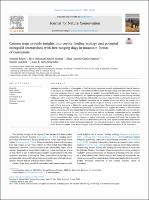| dc.contributor.author | Reyes, Gabriel | |
| dc.contributor.author | Serech-Gomez, Elvis Natanael | |
| dc.contributor.author | Cotto-Guzman, Elian Jacobo | |
| dc.contributor.author | Joachín, Emilio | |
| dc.contributor.author | Soto-Shoender, Jose R. | |
| dc.date.accessioned | 2025-08-26T19:52:38Z | |
| dc.date.available | 2025-08-26T19:52:38Z | |
| dc.date.issued | 2025-06-04 | |
| dc.identifier.uri | https://repositorio.catie.ac.cr/handle/11554/13797 | |
| dc.description.abstract | Although well studied in other regions of North America, coyotes are severely understudied in Central America. In this region, we recorded a series of videos that can inform coyote feeding ecology and interactions with other sympatric predators. Camera traps were placed to monitor terrestrial biodiversity in the Agua Volcano, a mountain forest ecosystem in Guatemala. We captured a sequence of videos of a female coyote carrying and then feeding on a white-nosed coati (Nasua narica). Additionally, our camera traps recorded a subsequent sequence of two free-ranging dogs (Canis lupus familiaris) scavenging on the remains of the coati left by the coyote. On a separate occasion, what appears to be the same coyote is captured walking in front of our camera traps and a pack of three dogs seem to follow the coyote several minutes later. These events provide basic information on coyote feeding ecology in mountain ecosystems of Central America and suggest that coyotes in this ecosystem may be interacting with free-ranging dogs by facilitating scavenging opportunities. Additionally, our records also suggest there is potential for other types of interactions such as interference competition and/or intraguild predation with free-ranging dogs. This is cause for concern as coyotes may be subsidizing free-ranging dogs, thereby exacerbating their negative impacts on native biodiversity and human well-being. We recognize the speculative nature and small sample size of our observations; however, these reports provide initial observations of coyote ecology in the region and suggest important new avenues of research to better understand current and future threats to coyotes posed by free-ranging dogs in biodiverse mountain ecosystems of the Neotropics. | es_ES |
| dc.description.sponsorship | Global Environmental Facility (GEF) | es_ES |
| dc.description.sponsorship | United Nations Development Program (UNDP) | es_ES |
| dc.description.sponsorship | Ministry of the Environment and Natural Resources (MARN) | es_ES |
| dc.description.sponsorship | Centro Agronómico Tropical de Investigación y Enseñanza (CATIE) | es_ES |
| dc.format.extent | 3 páginas | es_ES |
| dc.language.iso | en | es_ES |
| dc.publisher | Elsevier | es_ES |
| dc.relation.ispartof | Journal for Nature Conservation | es_ES |
| dc.relation.uri | https://doi.org/10.1016/j.jnc.2025.126982 | es_ES |
| dc.subject | Agua volcano | es_ES |
| dc.subject | Central America | es_ES |
| dc.subject | Coyotes | es_ES |
| dc.subject | Free-ranging dogs | es_ES |
| dc.subject | Guatemala | es_ES |
| dc.subject | Mountain ecosystems | es_ES |
| dc.subject | Scavenging | es_ES |
| dc.subject.other | Oficina Nacional Guatemala | es_ES |
| dc.title | Camera traps provide insights into coyote feeding ecology and potential intraguild interactions with free-ranging dogs in mountain forests of Guatemala | es_ES |
| dc.type | Artículo | es_ES |
| dc.identifier.status | restrictedAccess | es_ES |
| dc.subject.sdg | ODS 11 - Ciudades y comunidades sostenibles | es_ES |
| dc.subject.sdg | ODS 12 - Producción y consumo responsables | es_ES |
| dc.subject.sdg | ODS 13 - Acción por el clima | es_ES |
| dc.subject.sdg | ODS 15 - Vida de ecosistemas terrestres | es_ES |


